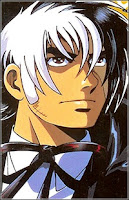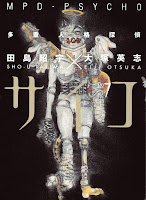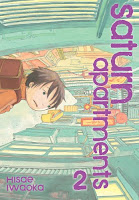My News and Reviews
Posts last week at Experiments in Manga included a new manga giveaway as well as two new in-depth manga reviews! There’s still time to enter the giveaway, too. Head over to the Battle Angel Alita Giveaway to enter for a chance to win the first omnibus in Yukito Kishiro’s manga series Battle Angel Alita: Last Order. As for the reviews: I took a look at the most recent Moyoco Anno manga to be released in English, Insufficient Direction. It’s an autobiographical manga about her married life with Hideaki Anno and is quite funny. I adore Anno’s work, so was happy to learn a little more about her. I also wrapped up my Manga March Madness project. I was rather pleased that I managed to pull it off. Every weekend in March I reviewed a volume of Takehiko Inoue’s basketball manga Real. Since there were five weekends in March and I started with the first volume in the series, my last review for the project was for Real, Volume 5. I hope I was able to at least begin to express why Real is such a fantastic manga in my reviews, because it really is a phenomenal series.
Speaking of Takehiko Inoue, David Brothers, writing for Comics Alliance back in 2010, had a great article that was recently brought to my attention again—From Samurai to Shooting Hoops: Takehiko Inoue, Art Chameleon. As for other things found online: Nahoko Uehashi (the author of Moribito) won the 2014 Hans Christian Andersen Author Award, which is a pretty big deal. As usual, Organization Anti-Social Geniuses had some great manga content last week. I particularly enjoyed What Manga Publishers Can Actually License in The US and Advice on Manga Editing, From Manga Editors. Tokyopop’s Stu Levy participated in a recent “Ask Me Anything” on Reddit. The daughter of Osamu Tezuka opened a drawer of her father’s desk that had been locked since 1985 and found some pretty cool stuff. And finally, I was pointed towards a brief biography of Takashi Nagasaki, who works closely with Naoki Urasawa.
Quick Takes
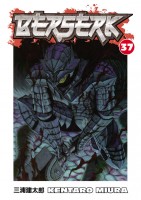 Berserk, Volume 37 by Kentaro Miura. I love the early story arcs of Berserk and continue to enjoy the series, so I’m always excited when another volume of the manga is finally released. After reading the thirty-seventh volume, I’m particularly anxious to get my hands on the next installment, whenever that may be. The battle between Guts and the rest of the crew against the sea god and its minions reaches its climax in this volume. They are aided by the merrow, Berserk‘s mermaids. Even though Miura’s version of mermaids is fairly traditional, though perhaps slightly more fish-like, I did like them. The thirty-seventh volume also contains a long flashback to Guts’ past as a young mercenary, which I particularly enjoyed reading. It’s set during a time when magic and the supernatural were more hidden and uncommon in the world, though hints of it could still be seen. The end of the volume also turns towards the current activities of Griffith’s army, which recently hasn’t had much prominence in the manga. After so much action and fighting, which I do enjoy, I’m very glad to see more story and plot development.
Berserk, Volume 37 by Kentaro Miura. I love the early story arcs of Berserk and continue to enjoy the series, so I’m always excited when another volume of the manga is finally released. After reading the thirty-seventh volume, I’m particularly anxious to get my hands on the next installment, whenever that may be. The battle between Guts and the rest of the crew against the sea god and its minions reaches its climax in this volume. They are aided by the merrow, Berserk‘s mermaids. Even though Miura’s version of mermaids is fairly traditional, though perhaps slightly more fish-like, I did like them. The thirty-seventh volume also contains a long flashback to Guts’ past as a young mercenary, which I particularly enjoyed reading. It’s set during a time when magic and the supernatural were more hidden and uncommon in the world, though hints of it could still be seen. The end of the volume also turns towards the current activities of Griffith’s army, which recently hasn’t had much prominence in the manga. After so much action and fighting, which I do enjoy, I’m very glad to see more story and plot development.
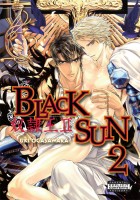 Black Sun, Volume 2 by Uki Ogasawara. It’s been quite a while since I read the first volume of Ogasawara’s boys’ love manga Black Sun. I had a few issues with the story itself, mostly that the lead characters’ relationship moved a little too quickly from lust to possible love, but overall I thought the manga had good potential. I particularly liked the setting of Black Sun, a medieval fantasy inspired in part by the Crusades. Ogasawara’s artwork was also excellent, with particular attention given to the beautiful details of clothing and weaponry as well as attractive, muscular men. When I read the first volume of Black Sun I didn’t actually realize that it was a first volume. I appreciated it’s somewhat ambiguous ending, but was ultimately glad to discover that there was more to the series. The ending of the second and final volume is much less ambiguous, and much happier than I expected that it would be. Black Sun is part of Digital Manga’s 801 Media imprint, so unsurprisingly there is a fair amount of sex to go along with the plot. And Black Sun actually does have a plot. The relationship between Jamal and Leonard plays out against a backdrop of war and political intrigue.
Black Sun, Volume 2 by Uki Ogasawara. It’s been quite a while since I read the first volume of Ogasawara’s boys’ love manga Black Sun. I had a few issues with the story itself, mostly that the lead characters’ relationship moved a little too quickly from lust to possible love, but overall I thought the manga had good potential. I particularly liked the setting of Black Sun, a medieval fantasy inspired in part by the Crusades. Ogasawara’s artwork was also excellent, with particular attention given to the beautiful details of clothing and weaponry as well as attractive, muscular men. When I read the first volume of Black Sun I didn’t actually realize that it was a first volume. I appreciated it’s somewhat ambiguous ending, but was ultimately glad to discover that there was more to the series. The ending of the second and final volume is much less ambiguous, and much happier than I expected that it would be. Black Sun is part of Digital Manga’s 801 Media imprint, so unsurprisingly there is a fair amount of sex to go along with the plot. And Black Sun actually does have a plot. The relationship between Jamal and Leonard plays out against a backdrop of war and political intrigue.
 From the New World, Volumes 2-3 written by Yusuke Kishi and illustrated by Toru Oikawa. I was very torn over the first volume of the From the New World manga. I absolutely loved its dark tone, but found the blatant, pandering fanservice to be a bit off-putting and out-of-place. Thankfully, the fanservice in the second volume is greatly toned down. The outfits worn by the young women are still fairly ridiculous and revealing, though, especially when compared to the male characters who tend to be covered from head to toe in oversized clothing. The lesbian sex returns in the third volume, but it makes much more sense within the context of the series than it did in the first volume. Part of this is because the worldbuilding has progressed significantly. From the New World suffers a little from large info dumps, but at least all of the information is new to the characters, too, so it’s not as egregious a problem as it could be. I’m still loving the actual story of From the New World. The series atmosphere is creepy and ominous, contrasting magnificently with what is supposed to be a perfect and pristine society. What humanity is willing to give up and the terrible steps that have been taken to maintain that system are now being revealed.
From the New World, Volumes 2-3 written by Yusuke Kishi and illustrated by Toru Oikawa. I was very torn over the first volume of the From the New World manga. I absolutely loved its dark tone, but found the blatant, pandering fanservice to be a bit off-putting and out-of-place. Thankfully, the fanservice in the second volume is greatly toned down. The outfits worn by the young women are still fairly ridiculous and revealing, though, especially when compared to the male characters who tend to be covered from head to toe in oversized clothing. The lesbian sex returns in the third volume, but it makes much more sense within the context of the series than it did in the first volume. Part of this is because the worldbuilding has progressed significantly. From the New World suffers a little from large info dumps, but at least all of the information is new to the characters, too, so it’s not as egregious a problem as it could be. I’m still loving the actual story of From the New World. The series atmosphere is creepy and ominous, contrasting magnificently with what is supposed to be a perfect and pristine society. What humanity is willing to give up and the terrible steps that have been taken to maintain that system are now being revealed.
 Swan, Volumes 13-15 by Kyoko Ariyoshi. In Japan, Swan lasted for twenty-one volumes, only fifteen of which were released in English. It’s too bad that CMX folded before the series could be completely released. Swan is fantastic, and I’m very glad for the fifteen volumes that were translated. These last three volumes of the English edition follow Masumi as she travels to New York with Leonhardt to continue her study of ballet following the aftermath of the Tokyo World Ballet Competition. It’s the beginning of an important new story arc. Masumi has grown tremendously as a ballerina as well as a person, but her time in the United States presents new challenges. Her foundation is in classical ballet but now she is faced with modern ballet which is completely outside of her experience. She has trouble understanding modern ballet and so struggles greatly with its performance. Also introduced in these volumes are new characters and even a potential new love interest, which offers another set of problems for Masumi to deal with. Swan is a beautiful and surprisingly intense series; I was very impressed by it.
Swan, Volumes 13-15 by Kyoko Ariyoshi. In Japan, Swan lasted for twenty-one volumes, only fifteen of which were released in English. It’s too bad that CMX folded before the series could be completely released. Swan is fantastic, and I’m very glad for the fifteen volumes that were translated. These last three volumes of the English edition follow Masumi as she travels to New York with Leonhardt to continue her study of ballet following the aftermath of the Tokyo World Ballet Competition. It’s the beginning of an important new story arc. Masumi has grown tremendously as a ballerina as well as a person, but her time in the United States presents new challenges. Her foundation is in classical ballet but now she is faced with modern ballet which is completely outside of her experience. She has trouble understanding modern ballet and so struggles greatly with its performance. Also introduced in these volumes are new characters and even a potential new love interest, which offers another set of problems for Masumi to deal with. Swan is a beautiful and surprisingly intense series; I was very impressed by it.
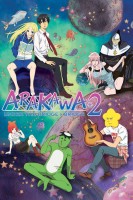 Arakawa Under the Bridge x Bridge, Season 2 directed by Akiyuki Shinbo. I enjoyed the first season of Arakawa Under the Bridge a great deal. I very much enjoyed the second season, too, but for some reason wasn’t quite as taken with it. I’m not really sure why that is though since not much really changed between the two. Arakawa Under the Bridge is still funny and absurd. I still like the humor and the characters. While the first season focused on Rec as he gets to know everyone living along the banks of the Arakawa River, everyone’s personalities and quirks have been well established by the start of the second. Maybe it’s that sense of newness and discovery that the second series lacks. But then again maybe not: the second season introduces new cast members as well as a storyline that provides an ongoing framework for some of the gags. (Ultimately it doesn’t really end up going anywhere, though.) One of the things that particularly amused me about the second season of Arakawa Under the Bridge is that Rec has more or less become a shoujo heroine, complete with flowers and sparkles. Nods to Riyoko Ikeda’s series are right at home alongside references to Fist of the North Star and other “manly” anime.
Arakawa Under the Bridge x Bridge, Season 2 directed by Akiyuki Shinbo. I enjoyed the first season of Arakawa Under the Bridge a great deal. I very much enjoyed the second season, too, but for some reason wasn’t quite as taken with it. I’m not really sure why that is though since not much really changed between the two. Arakawa Under the Bridge is still funny and absurd. I still like the humor and the characters. While the first season focused on Rec as he gets to know everyone living along the banks of the Arakawa River, everyone’s personalities and quirks have been well established by the start of the second. Maybe it’s that sense of newness and discovery that the second series lacks. But then again maybe not: the second season introduces new cast members as well as a storyline that provides an ongoing framework for some of the gags. (Ultimately it doesn’t really end up going anywhere, though.) One of the things that particularly amused me about the second season of Arakawa Under the Bridge is that Rec has more or less become a shoujo heroine, complete with flowers and sparkles. Nods to Riyoko Ikeda’s series are right at home alongside references to Fist of the North Star and other “manly” anime.
















